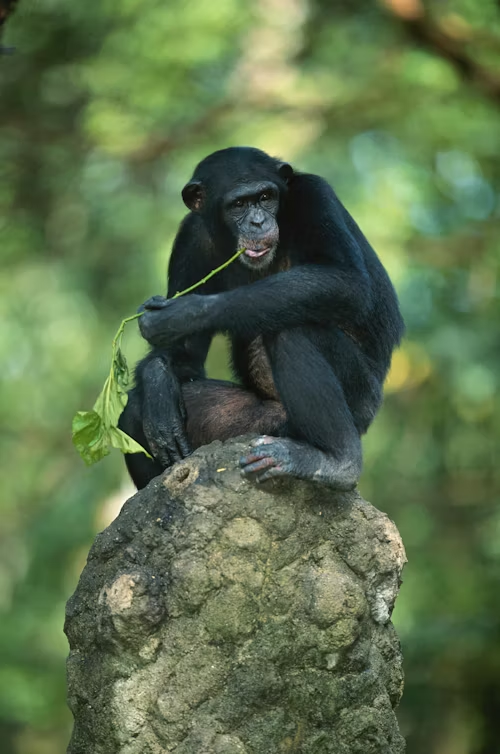Chimpanzees, our closest living relatives, have been captivating scientists for decades with their behavior, cognitive abilities, and the complex ways they communicate. Recent research has provided an even more intriguing look into their communication skills, particularly focusing on their drumming abilities. A new study shows that chimpanzees drum with regular rhythms when they beat on tree trunks, adding a fascinating dimension to their social communication.
This discovery holds significant implications, offering insights into the evolution of rhythmic behaviors in primates and, by extension, humans. Scientists suggest that the origins of our ability to create and use rhythm as a form of communication could date back millions of years to a common ancestor between humans and chimpanzees.
The study, led by Cat Hobaiter, a primatologist at the University of St Andrews, offers compelling evidence that rhythm is not solely a human characteristic but a fundamental trait shared by chimpanzees. Hobaiter and her team analyzed over 371 bouts of chimpanzee drumming and concluded that the chimps use a regular rhythm while drumming on tree trunks. This finding is groundbreaking because it suggests that the ability to produce rhythm is not a recent evolutionary development but rather something that predates the emergence of humans as a distinct species.
Chimpanzees, like humans, live in highly social groups, and communication plays an essential role in maintaining these relationships. While chimpanzees are known to communicate through a variety of vocalizations and gestures, drumming provides an additional layer of communication, one that is both unique and fascinating. According to Henkjan Honing, a researcher in music cognition at the University of Amsterdam, chimps “clearly play their instruments—the tree trunks—with regular rhythms.” This is a direct indication that drumming is not just a random act but an intentional and structured behavior.
Drumming in chimpanzees typically occurs when they are moving through the jungle. They often grab hold of the tall buttress roots of rainforest trees and pound them several times to create deep, low-frequency sounds. These drumming sessions can be heard for kilometers, allowing chimps to communicate over long distances. The researchers believe that the purpose of this drumming is to alert other chimps about their location, similar to a form of long-distance social checking-in. In essence, it serves as a way for chimps to “announce” their presence and their movement, helping them to stay connected in a dense and expansive environment.
The study further suggests that each chimpanzee has a unique drumming signature. This means that, much like a human’s voice, a chimp’s drumming style can be used to identify them. The rhythm, speed, and pattern of the drumming all contribute to the “signature” sound that allows other chimps to recognize who is making the noise. This type of rhythmic communication highlights the social nature of chimpanzees and their need for connection, even in the vast and noisy environment of the jungle.
The research also reveals regional differences in the drumming styles of chimpanzees. Chimpanzees from different parts of Africa exhibit distinct rhythmic preferences. Western chimpanzees, for instance, are more likely to produce even, consistent beats, while their eastern counterparts favor varied rhythms with alternating short and long intervals between beats. This finding is significant because it suggests that the drumming patterns could have regional variations, much like dialects in human languages. Just as people from different parts of the world speak with distinct accents, chimpanzees in different regions drum to different rhythms, indicating cultural diversity among chimpanzee groups.
The discovery that chimpanzees use tree roots as drumming tools also adds another layer of complexity to their behavior. Chimps are already known to use tools in a variety of ways, such as using sticks to “fish” for termites and rocks to crack open nuts. But the use of tree roots as percussion instruments is a novel and important finding. The chimps are selective about which roots they choose to drum on, preferring specific shapes and wood varieties that produce the best sounds. This indicates a level of sophistication in their tool use and a keen understanding of how different materials can affect the quality of the sound they produce.
The fact that chimps choose certain tree roots for their drumming activities also emphasizes the importance of the environment in shaping their behaviors. The dense jungle environment where they live is full of sounds, and being able to make a noise that travels far distances can be a vital tool for communication. By selecting the right type of tree roots to drum on, chimps are maximizing the effectiveness of their communication, ensuring that their calls are heard by others in their group, no matter where they are located in the jungle.
The findings from this study provide significant insight into the cognitive abilities of chimpanzees and the evolutionary roots of rhythmic behavior. By showing that chimps drum with regular rhythms, the study suggests that rhythm might not be uniquely human but rather an ancient trait shared by our primate relatives. This opens up new possibilities for understanding how rhythmic abilities evolved in our ancestors and how they may have contributed to the development of more complex forms of communication, such as language.
This research also invites further exploration into the social and cognitive aspects of chimpanzee behavior. The study highlights the role of rhythm in chimpanzee communities, providing a new lens through which to examine their social dynamics. It also raises questions about the relationship between rhythm and emotional expression in primates. Just as humans use rhythm and music to express emotions, it is possible that chimpanzees use their drumming to convey feelings such as excitement, frustration, or territoriality.
The findings of this study are not just important for understanding chimpanzee behavior but also for understanding the broader evolution of communication in primates. By studying the drumming behavior of chimpanzees, scientists can learn more about the development of communication systems in other species, including humans. This research may one day provide valuable insights into the origins of human music, rhythm, and language.
In conclusion, the discovery that chimpanzees drum with regular rhythms on tree trunks is a groundbreaking finding that sheds new light on the complexity of chimpanzee behavior. It suggests that rhythm and the use of sound for communication predate the evolution of humans and may have played a key role in the development of social structures and language. The study also highlights the importance of the environment in shaping behavior, as well as the sophistication of chimpanzees’ tool use. As scientists continue to explore the cognitive and social abilities of chimpanzees, they will undoubtedly uncover more fascinating insights into the minds of these remarkable creatures and their place in the evolutionary tree.


